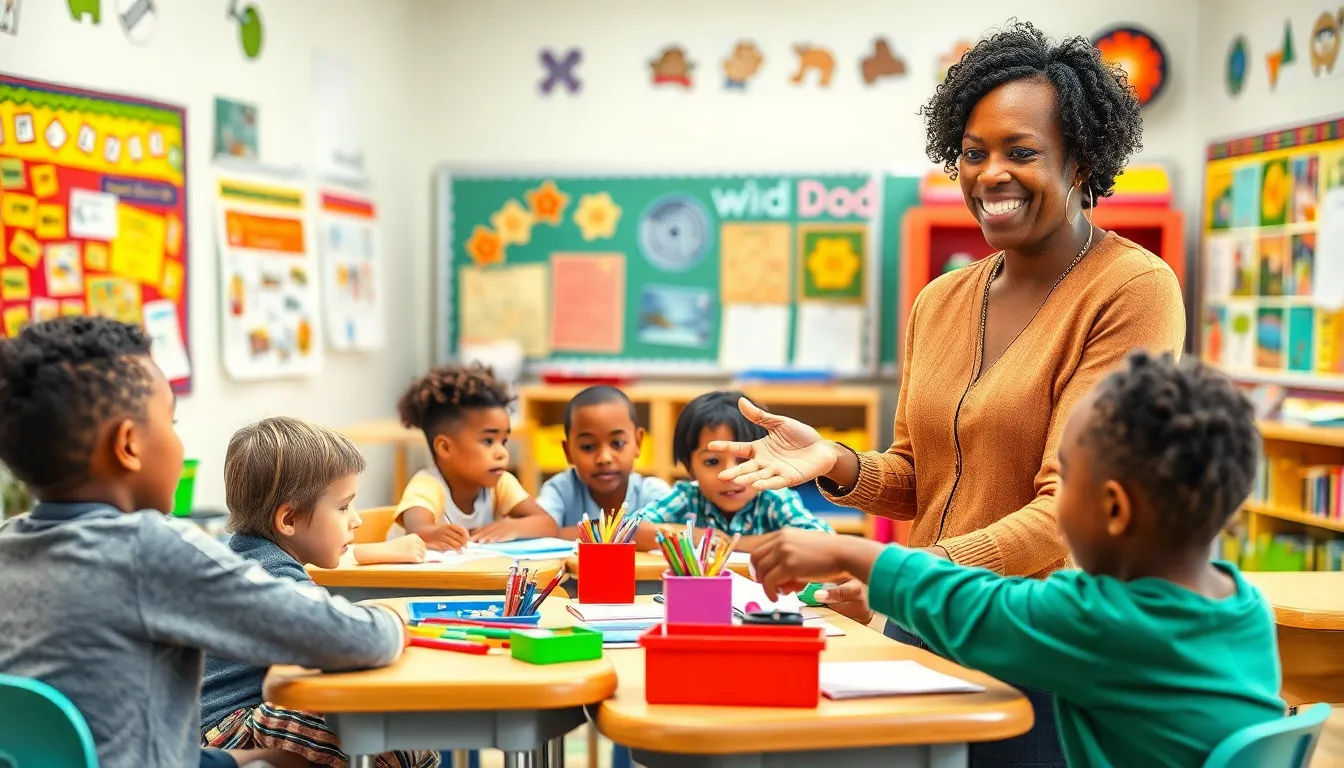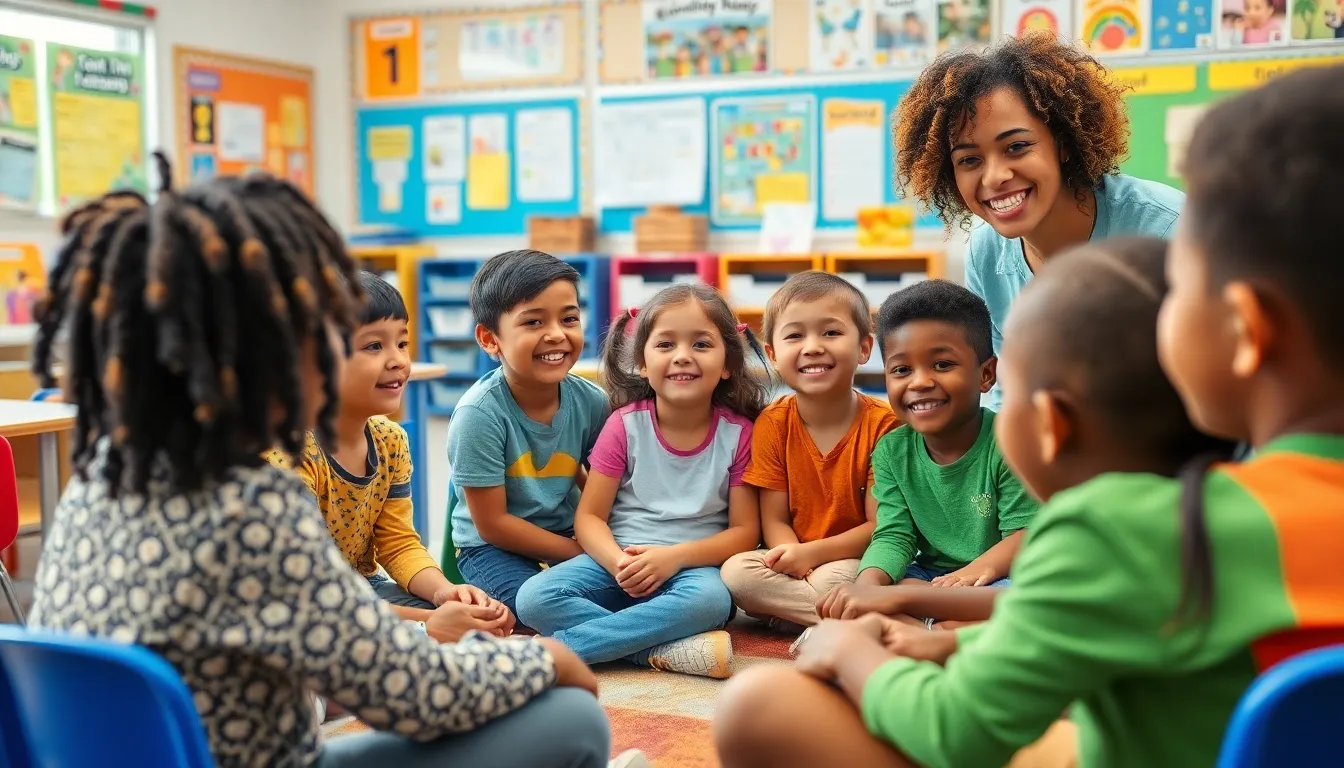In the bustling world of education, behavior discipline can feel like navigating a minefield—one wrong step and boom! But fear not, because mastering the art of behavior management in schools doesn’t have to be a daunting task. It’s all about finding that sweet spot between authority and approachability, where students can thrive while keeping their antics in check.
Table of Contents
ToggleUnderstanding Behavior Behavior Discipline
Behavior discipline in schools involves structured approaches to managing student conduct. Effective behavior management techniques prioritize clear expectations and consistent consequences. Educators establish a positive classroom environment that encourages respect and cooperation among students.
Strategies for behavior discipline include positive reinforcement. Recognizing and rewarding good behavior helps create motivation. Additionally, implementing clear rules clarifies what is expected, minimizing misunderstandings.
Building strong relationships with students enhances behavior discipline efforts. Teachers who are approachable foster trust, encouraging open communication about challenges. Individualized attention can address specific needs, leading to improved behavior outcomes.
Moreover, proactive measures play a critical role in behavior management. Identifying potential disruptions before they escalate helps maintain a focused learning atmosphere. Teaching social skills also equips students with tools to interact positively with peers.
Collaboration with parents reinforces the school’s behavior discipline approach. Regular communication between educators and families establishes a consistent message at home and school. Involving parents in discussions about behavior expectations promotes accountability.
Utilizing data-driven methods enables the tracking of behavior patterns. Schools can assess the effectiveness of their discipline strategies based on collected data. Adjustments made from this analysis can lead to improved practices, better aligning them with students’ needs.
Understanding behavior discipline in school settings requires a multifaceted approach. Prioritizing clear expectations, fostering relationships, and employing data-driven methods contribute to a supportive learning environment.
The Importance of Discipline in Schools
Discipline plays a crucial role in fostering an effective learning environment. It sets the foundation for student behavior and academic success.
Impact on Student Learning
Discipline directly influences student learning outcomes. When expectations are clear, students gain the confidence needed to engage actively in lessons. A structured atmosphere encourages focus, allowing learners to grasp concepts without unnecessary distractions. Additionally, classrooms that prioritize discipline reflect respect for both educators and peers, leading to a positive climate conducive to collaboration. Research indicates that students in disciplined environments achieve higher academic scores as they spend more time on task. Furthermore, teaching self-regulation and accountability through discipline equips students with lifelong skills essential for future success.
Role in Class Management
Classroom management hinges on effective discipline strategies. A well-disciplined classroom minimizes disruptions, enabling teachers to deliver lessons efficiently. By maintaining order, educators can devote more time to instruction and less to addressing behavioral issues. Establishing clear rules and consistent consequences fosters trust between teachers and students, creating an atmosphere where students feel safe to express themselves. Engaged students participate actively and contribute to class discussions, enhancing the overall learning experience. Strong classroom management through discipline also reduces stress for educators, allowing them to focus on developing their teaching methods and supporting individual student needs.
Effective Behavior Management Strategies
Effective behavior management strategies in schools foster a respectful and cooperative atmosphere. Creating a structured environment enhances learning and supports student development.
Positive Reinforcement Techniques
Positive reinforcement techniques promote desired behaviors. Recognizing achievements with praise or rewards builds students’ self-esteem. Specific acknowledgments, like highlighting individual improvements, motivate students to continue positive actions. Educators can implement reward systems, such as points or tokens, to encourage collaboration and responsibility. The consistent use of these techniques leads to lasting behavioral change, allowing students to feel valued and engaged. Tracking progress through positive reinforcement shows students the impact of their efforts, creating a culture of encouragement.
Consistency in Rules and Consequences
Consistency in rules and consequences is vital for maintaining order. Clear expectations provide a framework for behavior, making it easier for students to understand what is acceptable. When educators consistently enforce rules, students learn accountability and the importance of their actions. Consequences should be immediate and relevant to ensure comprehension. Regularly revisiting rules, especially in the beginning, reinforces understanding and compliance. Documenting behavior incidents allows educators to assess patterns and adjust strategies as needed, ensuring all students receive fair treatment. Clear and consistent discipline practices cultivate a safe environment where learning can thrive.
Challenges in Implementing Discipline
Implementing discipline in schools involves several challenges. Resistance from students presents a significant obstacle, as they may view disciplinary measures as unfair or punitive. Inconsistent application of rules can erode trust among students and undermine authority, making it crucial for educators to enforce policies uniformly.
Communication barriers with parents create additional complexities. While collaboration with families is vital, differing perspectives on discipline can lead to misunderstandings. Involving parents early in discussions about behavior expectations often helps cultivate a supportive environment.
Limited training for educators poses another challenge. Many teachers lack adequate professional development in behavior management strategies. Enhancing training programs to focus on effective discipline techniques can empower teachers to handle challenging situations more effectively.
Emotional and psychological factors also play a role. Students facing personal struggles may exhibit disruptive behavior, revealing a need for schools to address underlying issues. Incorporating social-emotional learning initiatives can aid in creating a more compassionate approach to discipline.
Resource allocation impacts the effectiveness of behavior management. Schools with limited funding may struggle to implement comprehensive discipline programs. Investing in targeted interventions, such as counseling services or behavior specialists, often yields improved outcomes.
Balancing authority and approachability proves essential. Establishing a connection with students encourages them to engage positively, but missteps in this balance can lead to loss of respect. Cultivating an environment where students feel safe to express themselves contributes to maintaining discipline.
Ultimately, understanding these challenges allows schools to devise more effective behavior management strategies. Addressing resistance, improving training, and fostering parental involvement can contribute to a more disciplined and positive learning atmosphere.
Innovations in Behavior Discipline Approaches
Modern behavior discipline approaches utilize technology to enhance student engagement and accountability. Digital tools, like applications for tracking behavior, offer real-time feedback to students and educators. Incorporating data analytics aids in identifying trends in behavior, allowing schools to tailor interventions more effectively.
Restorative practices gain traction in various educational settings, focusing on repairing harm rather than simply punishing misbehavior. This approach encourages open dialogue between students, fostering understanding and promoting empathy. Consequently, students feel more invested in their community, leading to a reduction in repeat offenses.
Trauma-informed discipline practices are also emerging as vital components of behavior management. Recognizing the impact of adverse childhood experiences equips educators with strategies to address underlying issues. Creating safe environments helps students feel secure, fostering better emotional regulation.
Social-emotional learning (SEL) programs play a key role in shaping positive behaviors. These programs teach students skills for managing emotions, setting goals, and resolving conflicts. Enhancing these competencies equips students with tools to navigate social dynamics, reducing incidents of disruption.
Collaboration within school communities strengthens behavior discipline. Engaging parents and guardians in discussions about expectations fosters a unified approach. Schools that prioritize strong home-school connections often see improvements in student conduct, as families support behavioral goals.
Peer mentoring programs encourage positive behaviors among students. By pairing younger students with responsible role models, schools promote accountability while fostering leadership skills. As a result, mentors reinforce the importance of good behavior and set a positive example for others.
Innovative approaches to behavior discipline focus on proactive strategies, emotional support, and community collaboration. These methods create a framework for nurturing positive student behavior in schools.
Effective behavior discipline in schools is essential for creating a positive learning environment. By implementing structured approaches and fostering strong relationships, educators can significantly enhance student engagement and achievement. The balance of authority and approachability allows students to thrive while maintaining necessary control.
Innovative strategies like positive reinforcement and restorative practices not only address disruptive behavior but also promote emotional well-being. Collaboration with parents and the use of technology further support these efforts, ensuring students receive consistent messages about behavior expectations.
Ultimately, schools that prioritize comprehensive behavior management strategies pave the way for a disciplined atmosphere where students feel safe and respected, leading to academic success and personal growth.






